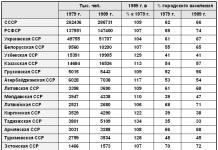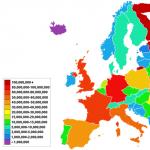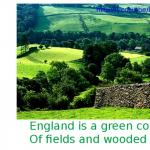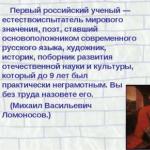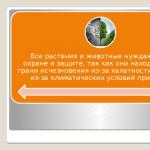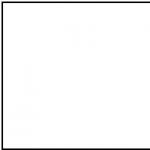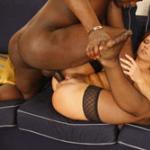English teacher MBOU Education Center Ugolnye Kopi Prozorova Valentina Petrovna
October 2018

Some facts about Canada
- Canada is one of the largest and richest countries in the world with a very high living standard.
- - The capital of the country is Ottawa. The state has two official languages: English and French.
- - The average length of people’s life in Canada is 81 years.
- - In 1965 the British Parliament adopted the national flag of Canada with maple leaf.
- - The state of Canada was founded on the first of July, 1867.
- - The national sport of Canada is hockey.
- - The Canadian James Naitsmith invented a basketball game to give the Canadians a chance to play this game during winter time.
- - Canadians are fond of eating cheese very much.

Canada's coat of arms
Crown on the emblem symbolizes the Canadian constitutional monarchy, headed by a king or queen. The shield represents a country where income Canadians ancestors - England, Scotland, Ireland, France, and also it’s a symbol of a unified nation out of many peoples.

Flag of Canada
The red and white colors of the Canadian flag are the national colors of Canada.
Maple Leaf in the center of the flag is the national tree of Canada.

Government
- Federal parliamentary constitutional monarchy.
- Monarch –Elizabeth II
- Governor General –
- David Johnston
- Prime Minister –
- Justin Trudeau
- Chief Justice –
- Beverley McLachlin

Geographical position
It’s the only country that is washed by the waters of three oceans: the Arctic, the Atlantic and the Pacific.
In the south Canada borders with the United States and in the north for 800 kilometers deepens the Arctic Circle.
Canada's highest point is Mount Logan.

Largest cities
Canada's largest cities are: Toronto, Montreal, Vancouver, Quebec. The capital of this state is Ottawa. This is one of the most important cultural centers in Canada, there are more than 30 museums, 50 galleries, various theaters.

Great Lakes. Superior, Michigan, Huron, Erie and Ontario.
Five Great Lakes in North America are the largest group of freshwater lakes on Earth.
Formed lake at the end of the last Ice Age, when the glacier began to retreat and melting water filled valley dug by ice. Lake Superior is the largest and the deepest.

animal world
Canada’s area is covered with tundra and gave shelter to reindeer, tundra wolf, hare, polar bears, polar foxes. In the dense forests are found refuge bobcats, squirrels,hares, deer and elks.
Coastal waters are rich in fish.

Among famous Canadian celebrities are:
- Evangeline Lily, an actress She plays the main part in the serial “To Stay Alive”

Ellen Page
Is also an actress. She is famous for the main role in the film “Juno” (Juno)

Christensen
Stars in a very popular film “Star Wars”

Linda Evangelista is one of the most popular top-models in the world

Arvin Lavigne
and Celine Dion are popular Canadian singers

Keanu Reeves
is the famous Hollywood star. He played in such famous blockbusters as “Matritsa”, “Speed” and “Street Kings”.

James Cameron
is also a Canadian.
He is a world famous producer and is known for his legendary film “Titanic”.

- THANK YOU
- Chukotka 2018

1 Capital
Prime-minister
GOVERNMENT
the Arctic Ocean, the Atlantic Ocean, the Pacific Ocean
3.Oceans
4. the Border
English and French
6.National languages
the Maple
7. National tree
Canadian dollar
8.Currency
Ten provinces and three territories
9. Provinces and territories

History of Canada. Canada's history is an exciting story of development of a vast wilderness into a great nation. Most experts believe that the first people who lived on this land came from Asia about 15,000 years ago. Their descendants are known today as Indians. The ancestors of the Eskimos came to Alaska after them probably about 5000 years ago. In 1497, John Cabot, an Italian navigator in the service of England, found rich fishing grounds off Canada's south-east coast. His discovery led to the European exploration of Canada. France set up a colony in eastern Canada in the early 1600"s. Great Britain gained control of the country in 1763, and thousands of British emigrants came to Canada. In 1867, the French and English-speaking Canadians helped to create a united colony called the Dominion of Canada.
Canada gained its independence from Britain in 1931.Canada is an independent federal state.
It is one of the most developed countries. Canada consists of ten provinces and three territories. It is located on the North American continent. In size Canada is the second in the world after Russia. Its area is almost 10 million square kilometers.
The capital of Canada is Ottawa.
It is also known as the city of bridges. Canada is very rich in forest, minerals and fur-bearing animals. It occupies the first place in the world in the amount of forests. Canadian industries produce cars, airlines, locomotives, sea vessels, snow-removal machines, and agricultural equipment. Canada grows wheat, barley, flax, potatoes, vegetables and fruit. Fishing is also one of the prosperous industries. Official languages of Canada are English and French. Canada is a founding member of the United Nations.


1 All Great lakes are located in Canada.
2 People speak American English in Canada.
3 The second official language in Canada is Spanish.
4 The capital of the country is Ottawa.
5 There live 18 million people.
6 In size Canada is the second in the world after Russia.
7 Canada consists of two states and six territories.
8 Machine-building became the first important industry in Canada.
9 Canada’s natural resources are not rich.

1 -- How do you do, Jane? Is it your first visit to Ottawa?
2 -- No, I was there many years ago. It was a brief visit.
1 – - You didn’t see much of Ottawa then, did you?
2 – - Very little, I"m afraid. This time I believe I"ll be able to visit many sights.
1 - - I"m sure you"ll find that we have an interesting, varied and beautiful city.
2 – Ottawa is full of different peoples, scenes and customs. You"ll have an exciting experience.

1 - Hello, could I ask you some questions about Canada?
2 - Hello, of course, what would you like to know?
1 - What is the capital of Canada?
2 – Oh, it's easy. Ottawa is the capital city.
1 - When was it founded? How many people live there?
2 – Well, It was founded in1850. More than 883,000 people live here.
1 – And two more questions. What is located in the capital? What kind of buildings are there in Canada?
2 – As far as I know, the National Gallery of Canada is located in the capital. There are a lot of government and historical buildings here, too.
1 – Well, thanks a lot for your answers, bye-bye.
2 – You're welcome, bye-bye.

“ What do you know about Canada?”

1. Canada is the… country in the world
a) Largest
b) Fifth largest
c)Second largest
d) Third largest
2. There are… provinces and three territories in Canada
3. Canada is...
a) a federal republic
b) a parliamentary republic
c) a monarchy
d) an independent federal state

4. Canada is situated on the … American continent
b)North
d)South
5. Canada is very … in forests, minerals and fur-bearing animals.
6. Official languages of Canada are English and… .
a) Italian
b) Spanish
c)German
d) French

7. The capital of Canada is….
a) London
b) Moscow
c) Ottawa
d) Liverpool
8. Canadian industries produce….
a) toys (toys)
c) produce (products)
d) clothes

9. Its area is almost … million square kilometers.
10. It is famous for its … parks.
a) terrible (terrible)
b) wonderful (wonderful)
c) awful (terrible)
d) beautiful

"Plus-Minus-Interesting"
Slide 1
CANADA Canada is a country occupying most of northern North America, extending from the Atlantic Ocean in the east to the Pacific Ocean in the west and northward into the Arctic Ocean. It is the world"s second largest country by total area and shares the world"s longest common border with the United States to the south and northwest.Slide 2
 National symbols of Canada The National Flag of Canada, also known as the Maple Leaf, is a red flag with a white square in its centre, featuring a stylized 11-pointed red maple leaf. The maple leaf is the characteristic leaf of the maple tree, and is an important national symbol of Canada The Royal Coat of Arms of Canada.
National symbols of Canada The National Flag of Canada, also known as the Maple Leaf, is a red flag with a white square in its centre, featuring a stylized 11-pointed red maple leaf. The maple leaf is the characteristic leaf of the maple tree, and is an important national symbol of Canada The Royal Coat of Arms of Canada.
Slide 3
 Politics Canada has a parliamentary government with strong democratic traditions. Parliament is made up of the Crown, an elected House of Commons, and an appointed Senate Canada is also a constitutional monarchy, with The Crown acting as a symbolic or ceremonial executive. The Crown consists of Queen Elizabeth II (legal head of state) and her appointed viceroys, the Governor General (acting head of state), and provincial Lieutenant-Governors
Politics Canada has a parliamentary government with strong democratic traditions. Parliament is made up of the Crown, an elected House of Commons, and an appointed Senate Canada is also a constitutional monarchy, with The Crown acting as a symbolic or ceremonial executive. The Crown consists of Queen Elizabeth II (legal head of state) and her appointed viceroys, the Governor General (acting head of state), and provincial Lieutenant-Governors
Slide 4
 The capital of the country is Ottawa. But the largest city is Toronto. This city is home to over 5 million people. Toronto is the third largest English-speaking city after London and New York. Montreal is the second largest French-speaking city after Paris. Canada is over 40 times bigger than the UK and 18 times bigger than France. There are two official languages in Canada: English and French.
The capital of the country is Ottawa. But the largest city is Toronto. This city is home to over 5 million people. Toronto is the third largest English-speaking city after London and New York. Montreal is the second largest French-speaking city after Paris. Canada is over 40 times bigger than the UK and 18 times bigger than France. There are two official languages in Canada: English and French.
Slide 5
 Ottawa Ottawa is the capital of Canada. One third of their people are French-speaking. It is located on the banks of the Ottawa, Rideau and Gatineau rivers. Canada’s fourth-largest city is a complementary blend of urban and rural lifestyles, old and new neighborhoods, culture and heritage, business and government.
Ottawa Ottawa is the capital of Canada. One third of their people are French-speaking. It is located on the banks of the Ottawa, Rideau and Gatineau rivers. Canada’s fourth-largest city is a complementary blend of urban and rural lifestyles, old and new neighborhoods, culture and heritage, business and government.
Slide 6
 The Great Lakes The Great Lakes are a chain of freshwater lakes located in eastern North America, on the Canada – United States border. Consisting of Lakes Superior, Michigan, Huron, Erie, and Ontario, they form the largest group of freshwater lakes on Earth. They are sometimes referred to as the "Third Coast" by some citizens of the United States. Because of their size, some regard them as inland seas.
The Great Lakes The Great Lakes are a chain of freshwater lakes located in eastern North America, on the Canada – United States border. Consisting of Lakes Superior, Michigan, Huron, Erie, and Ontario, they form the largest group of freshwater lakes on Earth. They are sometimes referred to as the "Third Coast" by some citizens of the United States. Because of their size, some regard them as inland seas.
Slide 7
 Lake Superior Lake Superior is the largest of the five Great Lakes of North America. It is the largest freshwater lake in the world by surface area and is the world"s third-largest freshwater lake by volume
Lake Superior Lake Superior is the largest of the five Great Lakes of North America. It is the largest freshwater lake in the world by surface area and is the world"s third-largest freshwater lake by volume
Slide 8
 The Niagara Falls The Niagara Falls are voluminous waterfalls on the Niagara River, straddling the international border between the Canadian province of Ontario and the U.S. state of New York. The falls are 17 miles (27 km) north-northwest of Buffalo, New York and 75 miles (120 km) south-southeast of Toronto, Ontario, between the twin cities of Niagara Falls, Ontario, and Niagara Falls, New York
The Niagara Falls The Niagara Falls are voluminous waterfalls on the Niagara River, straddling the international border between the Canadian province of Ontario and the U.S. state of New York. The falls are 17 miles (27 km) north-northwest of Buffalo, New York and 75 miles (120 km) south-southeast of Toronto, Ontario, between the twin cities of Niagara Falls, Ontario, and Niagara Falls, New York
Slide 9
 Yonge Street Yonge Street is a major arterial street in Toronto, Ontario, Canada, and its northern suburbs. It was formerly listed in the Guinness Book of Records as the longest street in the world,and is a national historic site.
Yonge Street Yonge Street is a major arterial street in Toronto, Ontario, Canada, and its northern suburbs. It was formerly listed in the Guinness Book of Records as the longest street in the world,and is a national historic site.
Slide 10
 Animals Canada is known for its vast forests and mountain ranges and the animals such as moose, beaver, caribou, polar bears, grizzly bears, Canada goose, Canada Lynx, and the common loon.
Animals Canada is known for its vast forests and mountain ranges and the animals such as moose, beaver, caribou, polar bears, grizzly bears, Canada goose, Canada Lynx, and the common loon.
Slide 11
 Canadian Horse The Canadian Horse is an official Canadian symbol and commonly appears in images with the Mounties.
Canadian Horse The Canadian Horse is an official Canadian symbol and commonly appears in images with the Mounties.
Slide 12
 The Royal Ontario Museum The Royal Ontario Museum, commonly known as the ROM, is located in Toronto, Ontario, Canada. It is Canada's largest museum of world culture and natural history. The ROM is the fifth largest museum in North America, containing more than six million items and over 40 galleries. It has notable collections of dinosaurs, Near Eastern and African art, East Asian art, European history, and Canadian history. It also hosts many traveling exhibits. The museum engages over 700,000 visitors each year.
The Royal Ontario Museum The Royal Ontario Museum, commonly known as the ROM, is located in Toronto, Ontario, Canada. It is Canada's largest museum of world culture and natural history. The ROM is the fifth largest museum in North America, containing more than six million items and over 40 galleries. It has notable collections of dinosaurs, Near Eastern and African art, East Asian art, European history, and Canadian history. It also hosts many traveling exhibits. The museum engages over 700,000 visitors each year.
- The project was done by
- Tolya Ostashkov, 10 form school 347,
- Saint - Petersburg, 2009
- (from Sea to Sea)
- The Origin of the Name
- Canada’s name comes from the Huron-Iroquois word kanata, which means “village” or “settlement”.
- The first French settlers used the Indian name for the colony but the official name was “New France”.
- The first use of “Canada” as an official name came in 1791 when the Province of Quebec was divided into the colonies of Upper and Lower Canada.
- When the area came under the British rule in 1897, the new country was called the Dominion of Canada or simply Canada
- Canada is the second largest country in the world. It occupies the northern part of North America and a number of islands. It’s total area is about 10 mln.km². It stretches from the Great Lakes in the south to the Arctic Circle in the north.
- Geographical
- position
- Geographical position
- Canada is bordered in the north by the Arctic Ocean, in the east by the Atlantic Ocean, in the south by the USA and in the west by the Pacific Ocean and Alaska.
- Provinces and Territories
- Canada is a federation of 10 provinces and 3 territories.
- There are also mountains which run parallel to Canada’s east coast, in Labrador and Baffin Land. The highest peak is in the Yukon territory. It is Mount Logan.
- The maple leaf is the official emblem of Canada. The official ceremony inaugurating the new Canadian flag was held on Parliament Hill in Ottawa on February 15, 1965. The national flag consists of a white field, flanked by a red vertical field on either end, with a red maple leaf on the white field.
- National Anthem
- The Coat of Arms
- Early settlers are represented by the three royal lions of England, the royal lion of Scotland, the harp of Ireland and the fleur-de-lis of France.
- The lion of England holds the British flag.
- The unicorn of Scotland holds the flag of Royal France.
- The bottom has the fleur-de-lis (France), the shamrock (Ireland), the thistle (Scotland), and the rose (England).
- The motto of Canada is A Mari
- Usque Ad Mare (From Sea to Sea)
- Symbols of Canada
- The beaver achieved official status as an emblem of Canada March 24, 1975.
- The maple leaf began to serve as a Canadian symbol as early as 1700.
- The color of the maple leaves on the arms of Canada was changed from green to red in 1957.
- The official languages of Canada are English and French.
- The population of Canada is over 33 million. people. Most of the inhabitants are of British and French origin. Indigenous people make up 3 per cent of the population. They include North American Indians, Metis and Inuit.
- Population
- In 1999 Canada’s Inuit were given their own territory called Nunavut.(Nunavut is the Inuit word for “our land.”) It is huge but extremely cold. About 29,500 Inuit live in Nunavut today. Only 6,200 Inuit live in Iqaluit, the capital of Nunavut.
- The inukshuk is the most famous symbol of the Inuit. These marks were used to help travelers and hunters not to get lost. You can see an inukshuk on the flag of Nunavut.
- Canada is a federal state within the Commonwealth of Nations.
- Formally the head of the state is the Queen of the UK. Although the Queen holds this high position, she doesn’t rule. She serves as a symbol of British tradition. Her representative in Canada is the Governor General, whom she appoints on the advice of the Canadian Prime Minister.
- The Governor's duties are limited to symbolic, mostly ceremonial acts.
- Michael Jean Governor-General of Canada
- The political system
- The real power belongs to the Prime Minister and his Cabinet. The Federal Parliament consists of the Senate, whose members are appointed by the Governor-General and the House of Commons, whose members are elected by the people for a period of five years.
- Stephan Harper Twenty-second Prime Minister of Canada
- Ottawa
- Ottawa is the federal capital of Canada. It is the seat of the federal Parliament and government.
- Toronto
- Vancouver
- Montreal
- Calgary
- Ice hockey is the national Canada’s sport.
- Maple syrup festival
- Canadians favorite sweet is maple syrup. Canadians like it so much that they even have special celebrations in honor of this sweet drink. They usually start at the beginning of March and last three to six weeks. During the festival you can see sap coming from the trees and help cook syrup in a “sugarhouse”. You can listen to live music and take part in funny contests. And you can eat lots of delicious maple products.
- References
- Canadian Heritage:
- http://www.canadianheritage.gc.ca/index_e.cfm
- Canada's Parliament: Symbols and Ceremony:
- http://www.parl.gc.ca/Information/Photos/Index-e.htm
- The Atlas of Canada:
- http://atlas.gc.ca/site/english/index.html
- Sing for Canada
- http://www.singforcanada.ca/anthem.html
- Wikipedia
- http://en.wikipedia.org/wiki/Canada
- Canadian Encyclopedia
- http://www.thecanadianencyclopedia.com/
Slide 2
about country
Canada is a constitutional monarchy with a parliamentary system. Area - 9984 thousand square meters. km. (second place in the world). It is washed by the Atlantic, Pacific and Arctic oceans. It borders the USA, Denmark and France. Population - 34 million people. The capital is Ottawa. It is a federal state consisting of 10 provinces and 3 territories. Official languages: English and French. Economy: diversified, based on rich natural resources and trade. MyGeography.ru
Slide 3
Geography
Canada occupies almost the entire northern half of the North American continent and numerous adjacent islands. In the east, the coast of the country is washed by the Atlantic, in the west by the Pacific, and in the north by the Arctic Ocean. The country's territory extends from 83 degrees north latitude in the north (Cape Columbia on Ellesmere Island) to 41 degrees north latitude in the south (Mild Island on Lake Erie). The area of the country is 9984 thousand sq. km. MyGeography.ru
Slide 4
Relief
The bulk of the country is occupied by prairie plains and the Canadian Shield plateau. To the west of the prairies are the continental lowlands of British Columbia and the Rocky Mountains, while the Appalachians rise from Quebec south to the Maritime provinces. The continental lands of the Canadian North are bordered to the north by a large archipelago, the Canadian Arctic Archipelago, which includes the largest islands in the world. This region of polar ice lies between the Queen Elizabeth Islands and is home to the magnetic north pole. The most populated area of the country is the Quebec-Windsor corridor along the lowland shores of the St. Lawrence River and the southeastern Great Lakes. MyGeography.ru
Slide 5
Rivers and lakes
MyGeography.ru Canada has more lakes than any other country in the world and has a significant supply of fresh water. In eastern Canada, the St. Lawrence River flows into the Gulf of St. Lawrence, having the largest estuary in the world, where the island of Newfoundland is located. New Brunswick and Nova Scotia are separated by the Bay of Fundy, which is famous for the highest tides in the world. North of the 60th parallel are numerous lakes (the largest being the Great Bear Lake and the Great Slave Lake) and are crossed by the longest river in the country, the Mackenzie River.
Slide 6
The Great Lakes are a system of freshwater lakes in North America, the United States and Canada. Includes a number of large and medium-sized reservoirs connected by rivers and straits. The area is about 245.2 thousand km², the volume of water is 22.7 thousand km³. The Great Lakes proper include the five largest: Superior, Huron, Michigan, Erie and Ontario. Several medium-sized lakes are associated with them. The lakes belong to the Atlantic Ocean basin. St. Lawrence River flow. MyGeography.ru Great Lakes
Slide 7
Niagara Falls is the common name for three waterfalls on the Niagara River, separating the American state of New York from the Canadian province of Ontario. Niagara Falls are Horseshoe Falls, sometimes also called Canadian Falls, American Falls and Veil Falls. Although the difference in height is not very great, the falls are very wide, and in terms of the volume of water passing through it, Niagara Falls is the most powerful in North America. The height of the waterfalls is 53 meters. The foot of the American Falls is obscured by a pile of rocks, which is why its apparent height is only 21 meters. The width of the American Falls is 323 meters, the Horseshoe Falls is 792 meters. The volume of falling water reaches 5700 or more m³/s. MyGeography.ru Niagara Falls
Slide 8
Climate
From the Pacific Ocean in the west to the Atlantic in the east, a temperate climate belt stretches in the southern part of the country. Average January and July temperatures vary for each area. Winter can be very harsh in some regions of the country, with average monthly temperatures reaching 15˚C below zero in the southern part of the country, and sometimes as low as −45˚C with strong icy winds. The minimum temperature ever observed in Canada is −63˚C (in the Yukon). Every year the level of snow cover can reach several hundred centimeters (for example, in Quebec the average is 337 cm). The coast of British Columbia, especially Vancouver Island, is an exception and has a temperate climate with mild and rainy winters. Summer temperatures can reach 35˚C, even 40˚C, given the humidity index. MyGeography.ru
Slide 9
Flora
Vegetation is represented by: deciduous forests, mixed forests, taiga, tundra, Arctic deserts of the North. The northern part of Canada is covered with tundra, which extends far to the south. Heathers, sedges, shrubby birch and willow grow here. To the south of the tundra there is a wide strip of forests. Coniferous forests predominate; the main species are black spruce in the east and white spruce in the west, pine, larch, thuja, etc. Less common deciduous forests consist of poplar, alder, birch and willow. Forests in the Great Lakes region are especially diverse (American elm, Weymouth pine, Canadian tsuga, oak, chestnut, beech). On the Pacific coast, coniferous forests of Douglas fir, Sitka spruce, Alaskan and red cedar are common); Arbutus and Oregon oak are found near Vancouver. In the coastal Atlantic provinces - Acadian forests with balsam fir, black and red spruce; also cedar, American larch, yellow birch, beech. MyGeography.ru
Slide 10
Fauna
The tundra zone is home to reindeer, polar hare, lemming, arctic fox and the original musk ox. To the south, the fauna is more diverse - forest caribou, red elk, elk, and in mountainous areas - bighorn sheep and bighorn goats. Rodents are quite numerous: the Canadian chikari squirrel, chipmunk, American flying squirrel, beaver, jumper from the jerboa family, muskrat, porcupine, meadow and American hare, pika. Among the cat predators for Canada are the Canadian lynx and the puma. There are wolves, foxes, gray bears - grizzlies, and raccoons. Mustelids include sable, pecan, otter, wolverine, etc. There are many nesting migratory birds and game birds. The fauna of reptiles and amphibians is not rich. There are a lot of fish in freshwater bodies. MyGeography.ru
Slide 11
State structure
MyGeography.ru Canada is a state that is part of the British Commonwealth, and formally the head of state is the Queen of England. The Queen's official representative in Canada is the Governor General. Canada is a parliamentary federal system with a democratic tradition. The legislative branch is represented by Parliament. Executive power is exercised by Her Majesty's Government - the Privy Council. The supreme bearer of executive power is the Queen. Judicial power in the country belongs to the Queen and the Royal Courts.
Slide 12
Economy
Canada is one of the richest countries in the world with a high per capita income, and is a member of the Organization for Economic Co-operation and Development (OECD) and the G8. Canada has a mixed economy. The largest importers of Canadian goods are the United States, Great Britain and Japan. The Canadian economy is dominated by the service sector. The primary sector of the economy is very important, with logging and the oil industry being the most important industries. Canada is one of the few industrialized countries that are net energy exporters. Atlantic Canada has vast offshore natural gas deposits and major oil and gas resources. Huge tar sands reserves make Canada the world's second largest oil reserves country after Saudi Arabia. Canada is one of the world's largest suppliers of agricultural products: wheat, canola and other grains. Canada is the largest producer of zinc and uranium, and is also a source of many other natural resources such as gold, nickel, aluminum and lead. Canada also has a developed manufacturing industry, the industries of which are concentrated in the south of Ontario (automotive industry, represented by American and Japanese factories) and Quebec (national aerospace industry). MyGeography.ru
Slide 13
Population
Canada is relatively sparsely populated. The population density (about 3.5 people per 1 km²) is one of the lowest in the world. The population of Canada is about 34 million people. The most populated area of the country is the Quebec-Windsor corridor along the lowland shores of the St. Lawrence River and the southeastern Great Lakes. The bulk of the population are descendants of immigrants from Europe: Anglo-Saxons, French Canadians, Germans, Italians, Ukrainians, Dutch, etc. The indigenous population - Indians and Eskimos - were pushed north during colonization. MyGeography.ru
Slide 14
Religion
Canadians practice a large number of religions. According to the latest census, 77.1% of Canadians consider themselves Christians, the majority of them are Catholics (43.6% of Canadians). The most important Protestant church is the United Church of Canada (Calvinists); approximately 17% of Canadians do not associate themselves with any religion, and the rest of the population (6.3%) professes religions other than Christianity (most often Islam). MyGeography.ru
Slide 15
Administrative division
Currently, Canada is divided into 10 provinces and 3 territories. The newest administrative unit of Canada is the territory of Nunavut (created in 1999). Provinces and territories differ in their degree of autonomy. The provinces are effectively given powers by the Constitution Act. MyGeography.ru
Slide 16
Big cities
Toronto is Canada's largest city, located at the intersection of water and land routes. Population - 2518 thousand inhabitants. The cities of Toronto, Brampton, Mississauga, Markham and others form the Greater Toronto Area (GTA) with a population of 5,715 thousand. About 1/3 of Canada's population lives in Toronto and its surrounding areas. Montreal is the oldest city in the country and the largest city in the province of Quebec with a population of 1,812,800 people. The city is inhabited mainly by French-Canadians, which is why the city is called “French Canada” or “Paris of North America”. Montreal is the industrial center of the country, as well as its huge transport hub. Montreal is a major river port. Vancouver is located in southwestern Canada, on the border with the United States. The population of the city itself is 600,000 people. (2006), but Greater Vancouver, including more than 20 suburbs, is home to over 2 million people. Vancouver is the largest port on the west coast of Canada, which is one of the largest business and industrial centers in the world. Calgary. Population - 1,230,248 people. As of 2002, Calgary ranks 31st in terms of living standards among 130 major cities in the world, and in 2002 it was recognized as the cleanest city on the planet. It is believed to have the cleanest water, the freshest air and the bluest sky. The city has more than 8,000 hectares of parks, 460 km of alleys and rivers. MyGeography.ru
Slide 17
Ottawa
MyGeography.ru Ottawa is the capital of Canada. Ottawa is the fourth largest city in the country and ranks 6th in terms of living standards in the world. Ottawa is located on the banks of the Ottawa River and the Rideau Canal. The city was founded in the 1820s. Until 1855 it was called Bytown. Since 1867 the capital of Canada. Population 875 thousand inhabitants. City government is carried out by the municipal council headed by the mayor. The climate is temperate continental. The average temperature in January is −11 °C, in July 20.3 °C. Precipitation is 873 mm per year. The appearance of Ottawa is characterized by an abundance of water and greenery, a checkerboard system of streets associated with a developed system of park roads. Residential buildings are mostly two-story.
Slide 18
Culture
Many elements of Canadian culture are very similar to U.S. culture, including film, television, clothing, housing, private transportation, consumer goods and food. Despite this, Canada has its own unique culture. In recognition of Canada's diversity of peoples, the country has had a multiculturalism policy since the 1960s. Elements from cultures around the world can be found in Canadian cities; in many cities there are neighborhoods dominated by a national minority (for example, Chinese, Italian, Portuguese neighborhoods in Toronto and Montreal), and festivals dedicated to the cultures of different countries are regularly held. The Maritime provinces preserve the Celtic folklore of the Irish and Scots, which at the same time fits well with the Gallo-Roman themes of Celtic Gaul, prevalent in Acadia and Quebec. The influence of Canada's indigenous population is also noticeable, with huge totem poles and other indigenous art found in many places. Canada's French-speaking population stands out significantly. It gives a special character to Canada; Montreal is the most important center of French-speaking culture in America. MyGeography.ru
View all slides

